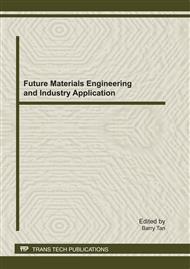[1]
Brashears, M.M., jaroni, D., Trimble, J., 2003. Isolation, selection, and characterization of lactic acid bacteria for a competitive exclusion product to reduce shedding of Escherichia coli O157: H7 in cattle. J. Food Prot, 355-363.
DOI: 10.4315/0362-028x-66.3.355
Google Scholar
[2]
Lee, Y .K., Salminen, S., 1995. The coming of age of probiotics. Trends Food Sci. Technol. 6, 241-245.
Google Scholar
[3]
Tannock, G. W., 1997. Probiotic properties of lactic acid bacteria: plenty of scope for fundamental R and D. Trends Biotechnol. 6, 270-274.
DOI: 10.1016/s0167-7799(97)01056-1
Google Scholar
[4]
RE Buchanan, NE Gibbons. Berger Bacterial Identification Manual [M]. Eighth Edition. Beijing: Science Press. 1995: 797-810.
Google Scholar
[5]
Qian Cheng, HUO Gui-cheng, Ma Wei. Functional properties and application prospects of Lactobacillus rhamnosus (LGG) [J]. Food Science and Technology , 2005(9): 94-98.
Google Scholar
[6]
Ma Pengfei, Chen You-liang, JinNiao-jun. Research progress in functional properties of Lactobacillus rhamnosus [J]. Science and Technology, 2009, 25(2): 82-96.
Google Scholar
[7]
Sazawal S, Hiremath G, Dhingra U, et al. Efficacy of pro-biotics in prevention of acute diarrhea: a meta-analysis of masked, randomized, placebo-controlled trials[J]. The Lancet Infectious Diseases, 2006, 6(6): 374-382.
DOI: 10.1016/s1473-3099(06)70495-9
Google Scholar
[8]
Alander M, Satokari R, Korpela R, et al. Persistence of colonization of human colonic mucosa by a probiotic strain, Lactobacillus rhamnosus GG, after oral consumption[J]. Applied and Environment Microbiology, 1999, 65: 351-354.
DOI: 10.1128/aem.65.1.351-354.1999
Google Scholar
[9]
Collado M C, Meriluoto J, Salminen S. In vitro analysis of probiotic strain combinations to inhibit pathogen adhesion to human intestinal mucus [J] Food Research International, 2007, 40(5): 629-636.
DOI: 10.1016/j.foodres.2006.11.007
Google Scholar
[10]
Miettinen M, Vuopio-Varkia J, Varkia K. Production of human tumor necrosis factor alpha, interleukin-6, and interleukin-10 is induced by lactic acid bacteria[J]. Infect Immun, 1996, 64: 5403-5407.
DOI: 10.1128/iai.64.12.5403-5405.1996
Google Scholar
[11]
Kankaanpa P, Tuomola E, EL-Nezami H, et al. Binding of aflatoxin B1 alters the adhesion properties of Lactobacillus rhamnosus strain GG in a Caco-2 model[J]. Food Protect, 2000, 63(3); 412-414.
DOI: 10.4315/0362-028x-63.3.412
Google Scholar
[12]
EL-Nezamai H S, Chrevatidis A, Auriola S, et al. Removal of common Fusarium toxins in vitro. by strains of Lacobacillus and Propionibacterium[J]. Food Additives and Contaminants, 2002, 19(7); 680-686.
DOI: 10.1080/02652030210134236
Google Scholar
[13]
Sgouras D, Maragkoudakis P, Petraki K. In vitro and in vivo inhibition of Helicobacter pylori by Lactobacillus casei strain Shirota. Applied and environmental microbiology, 2004, 1: 518-526.
DOI: 10.1128/aem.70.1.518-526.2004
Google Scholar
[14]
Saide Jao, Gilliland Se. Antioxidative activity of Lactobacilli measured by oxygen radical absorbance capacity. Journal of dairy science, 2005, 4: 1352-1357.
DOI: 10.3168/jds.s0022-0302(05)72801-0
Google Scholar
[15]
Xiong Tao, Wang Yun, ZengZhe-ling, et al. An improved method for rapid determination of the number of viable lactic acid bacteria [J]. Food and Fermentation Industries, 2009, 35(10): 132-134.
Google Scholar


